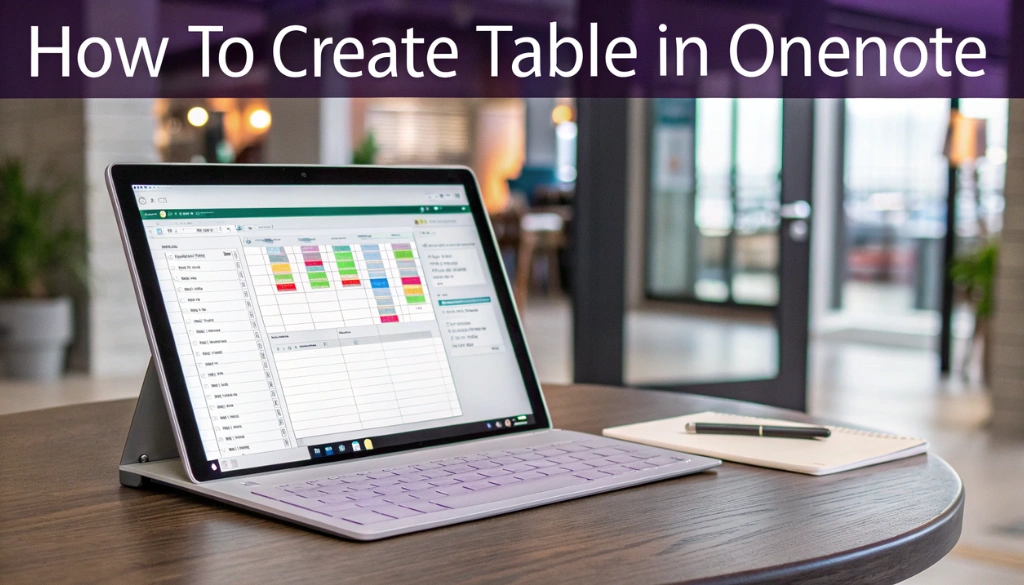Creating tables in OneNote can help us organize our notes better. Tables let us arrange information neatly, making it easier to read and understand. We can use tables for lists, project planning, or even taking notes in class.
To make a table, we simply click the Insert tab and choose the Table option. Then, we can decide how many rows and columns we need. It’s like drawing a grid where we can fill in our ideas. With tables, our notes become more structured, which boosts our productivity and helps us stay focused!
Key Takeaways
- To create a table in OneNote, go to the Insert tab and click the Table button, then select your desired size.
- Keyboard shortcuts, such as pressing the Tab key, can streamline the table creation process.
- You can customize tables by adding color to headers and modifying text formatting for better organization.
- For complex tables, consider creating them in another app and pasting them into OneNote if needed.
Inserting and Formatting Tables in OneNote:
Inserting and formatting tables in OneNote remarkably enhances your note-taking experience. To get started, click on Insert > Table. Then, drag your cursor over the grid to select the number of columns and rows you need. This creates a structured layout, making your notes easier to read and organize.
Here are key tips for effective table formatting:
- Cell Merging: Combine cells to create larger sections for headings or significant notes.
- Table Styles: Use different styles to visually distinguish sections, enhancing your notes’ appeal.
- Text Alignment: Align text within cells to increase readability.
Tables are perfect for organizing task lists, project planning, and research notes. They make easier effective data management and seamless collaboration.
By leveraging tables, you can transform your digital notebooks into powerful productivity tools. With practice, you’ll master the interface, making your notes both functional and visually appealing!
Using the Insert Tab
The Insert Tab in OneNote is necessary for creating organized notes. To add a table, click on Insert > Table, then drag your cursor over the grid to choose the desired number of columns and rows. This feature enhances your note-taking by streamlining data management.
Here are some key benefits of using tables in OneNote:
- Visual Organization: Tables structure information clearly, making it easy to read.
- Task Lists: Effortlessly create organized lists for projects or assignments.
- Collaboration: Sharing tables with classmates promotes teamwork and communication.
You can format tables by merging cells, adjusting text alignment, and applying different styles. This customization allows you to design templates that reflect your personal style and needs. For advanced formatting tips, check out this formatting guide.
Utilizing the Insert Tab transforms your digital notebooks into powerful tools for research, project planning, and data management. Mastering tables in OneNote boosts productivity and enhances your in general learning experience.
Keyboard Shortcuts for Table Creation
Creating tables in OneNote transforms your note-taking experience. To insert a table, click on Insert > Table, then drag your cursor across the grid to select the desired number of columns and rows. This method utilizes effective keyboard shortcuts that improve your workflow.
Here are key keyboard shortcuts for table creation:
- Ctrl + T: Insert a new table.
- Tab: Move to the next cell.
- Shift + Tab: Move to the previous cell.
- Ctrl + Shift + +: Insert a new row.
- Ctrl + -: Delete the selected row.
These shortcuts streamline data management, if you’re organizing task lists or planning projects. You can also format tables by adjusting text alignment, merging cells, and applying different styles. This flexibility makes OneNote a powerful tool for collaboration and data management.
By mastering these shortcuts, you can create visually appealing tables that improve information layout and improve productivity in your digital notebooks.
Customizing Table Features for Better Organization:[
Customizing table features in OneNote remarkably enhances your note-taking experience. Tables help you visually organize information, simplifying task and project management. Here’s how to tailor tables for better organization:
- Insert a Table: Go to Insert > Table, then drag to select the desired number of rows and columns.
- Adjust Column Width: Resize columns by clicking and dragging the borders to improve data visibility.
- Merge Cells: Select the cells you want to combine, right-click, and choose Merge Cells for a cleaner layout.
- Color Code: Use different colors for rows or cells to categorize information, enhancing visual clarity.
These features empower you to create effective task lists, manage projects, and collaborate effortlessly. By customizing your tables, you transform your digital notebooks into powerful productivity tools.
| Table Feature | Benefit |
|---|---|
| Custom Colors | Enhances visual clarity |
| Merged Cells | Simplifies information layout |
Cell Merging and Text Alignment
In OneNote, cell merging and text alignment are critical for enhancing table functionality. Merging cells creates a unified space for headings or key notes, boosting clarity. For instance, merging cells for a project title highlights its importance in a project plan.
To merge cells, select the desired cells, right-click, and choose the merge option. This method organizes data effectively. Aligning text within cells also enhances readability. You can position text to the left, center, or right according to your preference.
Follow these steps to align text:
- Select the cell or cells.
- Right-click and choose Table Properties.
- Select the alignment option that suits your needs.
These features remarkably improve the visual organization of your notes, enhancing productivity. Customizing tables makes your digital notebooks more effective for collaboration and information management.
| Feature | Benefit |
|---|---|
| Cell Merging | Creates a unified space for clarity |
| Text Alignment | Improves readability and presentation |
Utilizing these features in OneNote allows for effective note structuring, making information easier to steer and understand. This is especially beneficial for project management and task lists, where clarity is necessary.
Table Shading and Header Colors
In OneNote, table shading and header colors remarkably improve the note-taking experience. Customizing these features improves visual organization and emphasizes key information. For instance, using a light-colored header allows for quick section identification in your notes.
To customize shading and colors, follow these steps:
- Select the table you wish to modify.
- Click on the Table Tools tab that appears.
- Choose Shading to select a color for the cells.
- For headers, highlight the row and apply a distinct color for emphasis.
These techniques improve data management and increase productivity. For example, when using advanced features in OneNote, a well-organized table facilitates effective task tracking.
Utilizing different colors can categorize information, making it especially useful for project planning and collaboration. By visually distinguishing sections, we simplify the layout for all participants.
| Feature | Benefit |
|---|---|
| Table Shading | Enhances visual appeal and organization |
| Header Colors | Highlights significant sections for quick access |
By mastering these features, you can transform your digital notebooks into powerful tools for efficient note-taking. Whether for school projects or personal organization, well-formatted tables remarkably improve productivity.
Collaborating and Sharing Tables in OneNote:[
Using tables in OneNote remarkably enhances your note-taking and organization skills. They offer a clear method for managing information, especially for project planning and task lists. To create a table, simply select Insert > Table from the menu and drag to choose your desired number of rows and columns.
Once your table is set up, customize it with annotations or formatting adjustments to increase clarity. This flexibility improves data management and the in general presentation of your notes. Also, sharing tables with classmates or teammates is easy, making collaboration seamless.
Here’s a sample table:
| Task | Status |
|---|---|
| Research Topic | Completed |
| Draft Outline | In Progress |
Sync your tables across devices using cloud storage to keep your notes accessible anytime, anywhere. For more tips on effective table formatting, check out this guide. Utilizing tables in OneNote can greatly improve productivity and organization in both educational and personal contexts.
Syncing Across Devices
Syncing across devices in OneNote is necessary for staying organized. Imagine collaborating on a school project: you create a table on your laptop, and with cloud storage, it updates instantly on your tablet or phone. This seamless syncing makes sharing notes and working with classmates effortless!
Here’s how syncing enhances productivity:
- Accessibility: Access your notes anytime, anywhere.
- Collaboration: Work together in real-time.
- Organization: Keep everything neat and tidy.
To insert a table, follow these simple steps:
- Click on Insert.
- Select Table.
- Choose your desired grid size.
| Device | Sync Status |
|---|---|
| Laptop | Synchronized |
| Tablet | Synchronized |
| Phone | Synchronized |
With OneNote, your notes are always up-to-date. For more effective tips on using OneNote, check out this cheat sheet to manage your tasks and projects smoothly!
Exporting Tables to Other Formats
Exporting tables from OneNote to different formats enhances your note-taking experience, enabling seamless sharing with classmates or colleagues. Follow these straightforward steps to export a table:
- Select the table: Click on the table you wish to export.
- Copy the table: Press
Ctrl + Cto copy it. - Paste in another application: Open a program like Word or Excel and press
Ctrl + Vto paste it.
This method keeps your data organized and accessible, allowing for further formatting in those applications. For advanced formatting options, check out this guide.
| Format | Description |
|---|---|
| CSV | Comma-separated values for easy data import. |
| Excel | Retains formatting and supports advanced calculations. |
Exporting tables boosts your productivity and organization, making collaboration and note-sharing more efficient!
Summing up
Creating tables in OneNote helps us keep our notes organized and clear. We can easily add rows and columns to fit our needs. Plus, sharing these tables with friends or classmates makes teamwork easier. Whether for school projects or personal lists, tables can make our information look neat and easy to read. So, let’s start using tables to increase our note-taking skills and stay organized together!
2 thoughts on “Creating Tables in OneNote: Your Guide to Organized Notes”
Comments are closed.


Pingback: Mastering OneNote Web Clipper for Efficient Research | MSW Tutor.
Pingback: Microsoft OneNote for Students: Your Complete Study Companion | MSW Tutor.